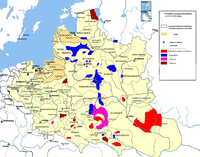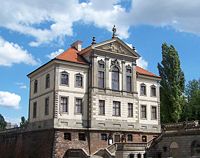- Ostrogski family
-
Ostrogski 
Ostrogski.Ethnicity Ruthenian/Ukrainian Current region Ukraine Information Place of origin Ostroh Notable members Daniil Ostrogski
Feodor Ostrogski
Konstanty OstrogskiConnected families Sanguszko, Zasławski Estate Ostroh Castle
Ostrogski PalaceOstrogski (Polish: Ostrogscy, Lithuanian: Ostrogiškiai, Ukrainian: Острозькі-Ostroz'ki, Russian: Острожские -Ostrozhskie) was one of the greatest Ruthenian princely families of the Grand Duchy of Lithuania.
They were most likely of Rurikid stock and descended from Sviatopolk II of Kiev. Some scholars however claim their descent from Galicia-Volhynia line of Rurikid dynasty. Vasilko Romanovich (c.1256-1282) Prince of Slonim may have been grandfather of Prince Daniel Ostrogski.[1] The probable progenitor of this family was Prince Danylo Dmytrovych (or Danylo Wasilijewicz), who received Ostroh from Liubartas, King of Galicia-Volhynia and son of Grand Duke of Lithuania Gediminas. His son, Prince Feodor Danilovich Ostrogski, was a supporter of King Jagiello, who in 1386 confirmed him in possession of the Ostroh Castle and appointed governor of Volhynia in 1387.[2] In addition to Ostrog Feodor Danilovich Ostrogski became owner of Korets, Zaslav (Izyaslav, in present Khmelnytskyi Oblast, Ukraine), and other towns. In some chronicles Feodor is called Dux Fethko de Ostrog.[3] Their dominions in Volynia, Galicia, and Podolia included 24 towns, 10 townlets, and more than 100 villages.
The most notable among Feodor's descendants was Grand Hetman of Lithuania, Prince Konstanty Ostrogski, who defeated Muscovy in the Battle of Orsha (1514) and his son Konstanty Wasyl Ostrogski (or Konstantin Konstantinovich Ostrozhski). Unlike other Ruthenian magnates, the Ostrogskis refused to give up Eastern Orthodoxy for Roman Catholicism despite the cultural pressure that led to Polonization of Ruthenian nobility. For several generations the Ostrogskis supported the religion of their forefathers, by opening schools, printing books in Ruthenian language with Cyrillic alphabet such as "Ostrog Bible" (written by Ivan Fedorov) and making a generous charitable contributions to the construction of the Orthodox churches in the region.
The last male member of the family was Janusz Ostrogski (d. 1620); the last female, Anna Alojza Ostrogska (1600–54), married to Grand Hetman Jan Karol Chodkiewicz. When a junior line of the family (princes Zasławski or Zasławski-Ostrogowski) which inherited the Ostrogoski's fortune went extinct in 1682 (with the death of Aleksander Janusz Zasławski), their huge possessions passed to the Lubomirski (due to their marriage with Aleksander sister, Teofilia Ludwika Zasławska) and other families of Polish szlachta. A complicated litigation concerning Ostrogski inheritance continued until Russian Empire annexed Poland during Partitions.
Contents
Notable family members
- Daniil Ostrogski (? - after 1366), ancestor of the Ostrogski house.
- Feodor Ostrogski (1360–1446), governor of Volhynia.
- Konstanty Ostrogski (1460–1530) - Hetman of the Polish–Lithuanian Commonwealth.
- Ilia Ostrogski (1510–1539), Braclaw starost
- Elizaveta Ostrogska (1539–1582)
- Konstanty Wasyl Ostrogski (1526–1608), marshal of Volhynia and voivode of the Kiev Voivodeship.
- Janusz Ostrogski (1554–1620), Voivode of Volhynian Voivodship and castellan of Kraków.
- Aleksander Ostrogski (1571–1603), Voivode of the Volhynian Voivodship.
- Aleksander Janusz Zasławski-Ostrogski (c.1650 - 1682), Last of Dukes Ostrogski-Zasławski.
- Władysław Dominik Zasławski-Ostrogski (c.1616-1656), Voivode of Sandomierz Voivodship.
- Zofia Ostrogska (1595–1662), married Stanisław Lubomirski.
- Anna Alojza Ostrogska (1600–1654), married Jan Karol Chodkiewicz.
- Katarzyna Ostrogska (1602–1642), married Tomasz Zamoyski.
- Teofilia Ludwika Zasławska (1650–1709), married Dymitr Jerzy Wiśniowiecki, then Józef Karol Lubomirski
- Katarzyna Ostrogska (1560–1579), married Krzysztof Mikołaj "the Thunderbolt" Radziwiłł
See also
External links
- Ostrogski Dynasty (In Ukrainian)
- Genealogy of the Ostrogski family (In Polish)
- Polish-Lithuanian nobility.(in German)
References
- ^ Opis starożytnéy Polski By Tomasz Święcki
- ^ Ostrogski in the Encyclopedia of Ukraine, vol. 3 (1993)
- ^ Jan Długosz Annales seu cronici incliti regni Poloniae in 1432 year
Categories:- History of Ukraine
- Ostrogski family
- Lithuanian noble families
- Ruthenian nobility
- Ukrainian nobility
- Ukrainian genealogy
Wikimedia Foundation. 2010.


